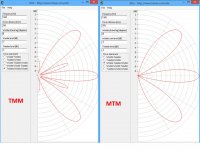A properly designed MTM using 5" drivers should produce a listenable main lobe.I have not purchased the mid range drivers yet - will be using the SB Acoustics MW13P-8 which is a 5inch driver. Shadders.
-------------- MW19P = 158cm^2 ------- MW13P = 70cm^2
I built a pair of Satori MW19P-4 + SB29RDC-4 monitors and really enjoy vocals on these speakers. I used 1650Hz passive mid_BW3 - tweet_BW3_reversed crossover ckt to reduce phase effects around the crossover.
Troels Gravensen built a MW19P studio monitor: "The MW19 monitor first impression is the bass. This is a potent 7" driver and delivers a firm and solid bass performance. Midrange is smooth and extremely transparent without accentuation or depression of any midrange area. Due to the low point of crossover the dispersion in upper-mid/lower-treble is excellent and provides a wide listening window. The TW29 tweeter delivers an astonishing treble. This tweeter has become one of my favorites and seems capable of mating any high-quality midrange driver. I couldn't ask for more. "
MW19P-8
===========
Active crossovers cannot fix edge diffraction effects, or MTM / TMM mid-mid lobing effects. At some listening angles, a pressure wave on one midrange cone point will combine with a reverse pressure wave from the other midrange at the listener's ear and generate a null. Even with active xovers, there are good reasons to build a 3-way TMW with attention to cabinet diffraction(bevels, rounds, tweeter offset). Great white papers from British engineers at B&W and Vivid.
Attachments
Hi LineSource,A properly designed MTM using 5" drivers should produce a listenable main lobe.
-------------- MW19P = 158cm^2 ------- MW13P = 70cm^2
I built a pair of Satori MW19P-4 + SB29RDC-4 monitors and really enjoy vocals on these speakers. I used 1650Hz passive mid_BW3 - tweet_BW3_reversed crossover ckt to reduce phase effects around the crossover.
Troels Gravensen built a MW19P studio monitor: "The MW19 monitor first impression is the bass. This is a potent 7" driver and delivers a firm and solid bass performance. Midrange is smooth and extremely transparent without accentuation or depression of any midrange area. Due to the low point of crossover the dispersion in upper-mid/lower-treble is excellent and provides a wide listening window. The TW29 tweeter delivers an astonishing treble. This tweeter has become one of my favorites and seems capable of mating any high-quality midrange driver. I couldn't ask for more. "
MW19P-8
===========
Active crossovers cannot fix edge diffraction effects, or MTM / TMM mid-mid lobing effects. At some listening angles, a pressure wave on one midrange cone point will combine with a reverse pressure wave from the other midrange at the listener's ear and generate a null. Even with active xovers, there are good reasons to build a 3-way TMW with attention to cabinet diffraction(bevels, rounds, tweeter offset). Great white papers from British engineers at B&W and Vivid.
Thanks for the write up and link - i recall this software site tolvan, so will have a play with the programs.
I have some basic books - but this site should allow to see the results of what is referred to in the books.
Thanks again for the information.
EDIT : I had a play with the program - as expected, the optimal listening position is in the main lobe direction. The datasheets only provide the dB loss with respect to frequency and 30deg and 60deg offset from the driver centre. From rf work, as expected, the higher the frequency then the more focussed/thinner the main lobe becomes.
Regards,
Shadders.
Last edited:
Hi GM,
Thanks for this, much appreciated.
Regards,
Shadders.
- Status
- This old topic is closed. If you want to reopen this topic, contact a moderator using the "Report Post" button.
